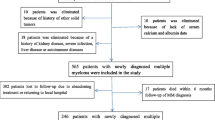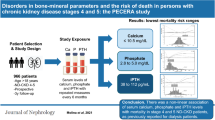Abstract
We studied the serum phosphorus (P) level of 110 patients with multiple myeloma (MM) (age range 42–83 years, median 62 years) and evaluated the relationship between that and other prognostic factors. Serum P level significantly correlated with the prognostic factors that are relevant to renal dysfunction: serum creatinine (P<0.00000001), serum β2-microglobulin (P=0.00000088), serum uric acid (P=0.0000014), and corrected serum calcium (cCa P=0.000067). Although it also correlated with the percentage of plasma cells in bone marrow nucleated cells (BMPC%) and the hemoglobin (Hb) and leukocyte counts, the significance was less than for the other four prognostic factors. Serum creatinine, BMPC%, leukocyte count, serum uric acid, bone lesions, β2-microglobulin, and serum cCa were all significantly higher and Hb significantly was lower in the MM patients with hyperphosphatemia (serum P>3.8 mg/dl). The survival time was significantly shorter in these patients (P=0.000087). Multivariate analysis (Cox’s proportional hazards regression model) showed that the serum P level is a significant negative prognostic factor in MM patients.

Similar content being viewed by others
References
Holick MF, Krane SM, Potts JT (1987) Phosphorus, disorders of bone and mineral metabolism. In: Braunwald E, Isselbacher KJ, Petersdorf RG, Wilson JD, Martin JB, Fauci AS (eds) Harrison’s principles of internal medicine, 11th edn. McGraw-Hill, New York, pp 1859–1860
Pettersson T, Hortling L, Teppo AM, Toetterman KJ, Fyhrquist F (1987) Phosphate binding by a myeloma protein. Acta Med Scand 222:89–91
Mandry JM, Posner MR, Tucci JR, Eil C (1991) Hyperphosphatemia in multiple myeloma due to a phosphate-binding immunoglobulin. Cancer 68:1092–1094
Busse JC, Gelhard MA, Byrenes JJ, Hellman R, Vaamonde CA (1987) Pseudohyperphosphatemia and dysproteinemia. Arch Intern Med 147:2045–2046
Sonnenblick M, Eylath U, Brisk R, Eldad C, Hershko C (1986) Paraprotein interference with colorimetry of phosphate in serum of some patients with multiple myeloma. Clin Chem 32:1537–1539
Adler SG, Laidlaw SA, Lubran MM, Kopple JD (1988) Hyperglobulinemia may spuriously elevate measured serum inorganic phosphate levels. Am J Kidney Dis 11:260–263
Oren S, Feldman A, Turkot S, Lugassy G (1994) Hyperphosphatemia in multiple myeloma. Ann Hematol 69:41–43
Marcu CB, Hotchkiss M (2004) Pseudohyperphosphatemia in a patient with multiple myeloma. Conn Med 68:71–77
Chronic Leukemia–Myeloma Taskforce, National Cancer Institute (1973) Proposed guidelines for protocol studies 11. Plasma cell myeloma. Cancer Chemother Rep 3 4:145–158
Durie BGM, Salmon SE (1975) A clinical staging system for multiple myeloma. Cancer 36:842–854
Alexanian R, Salmon S, Bonnet J, Gehan E, Haut A, Weick J (1977) Combination therapy for multiple myeloma. Cancer 40:2765–2771
Peto, R, Pike MC, Armitage P, Breslow NE, Cox DR, Howard SV, Mantel N, McPherson K, Peto J, Smith PG (1977) Design and analysis of randomized clinical trials requiring prolonged observation of each patient II: analysis and examples. Br J Cancer 35:l–39
Payne RB, Little AJ, Williams RB, Milner JR (1973) Interpretation of serum calcium in patients with abnormal proteins. BMJ 4:643–646
Kaplan EL, Meier P (1958) Nonparametric estimation from incomplete observations. J Am Stat Assoc 53:457–481
Cox DR (1972) Regression models and life tables. J R Stat Soc 34:187–196
Weinberg J, Adler AJ (1989) Spurious hyperphosphatemia in patients with dysglobulinemia. Miner Electrolyte Metab 15:185–186
McCloskey EV, Galloway J, Morgan MA, Kanis JA (1989) Pseudohyperphosphatemia in multiple myeloma. BMJ 299:1381–1382
Barutcuoglu B, Parildar Z, Mutaf I, Habif S, Bayindir O (2003) Spuriously elevated inorganic phosphate level in a multiple myeloma patient. Clin Lab Haematol 25:271–274
Loghman-Adham M, Walton D, Iverius PH, Deiss A, Knight JA, Cheung AK (1997) Spurious hypophosphatemia in a patient with multiple myeloma. Am J Kidney Dis 30:571–575
Caras JA (1997) Spurious hypophosphatemia associated with multiple myeloma. Endocr Pract 3:135–136
Dash T, Parker MG, Lafayettw RA (1997) Profound hypophosphatemia and isolated hyperphosphaturia in two case of multiple myeloma. Am J Kidney Dis 29:445–448
Weisbord SD, Chaudhuri A, Blauth K, DeRubertis FR (2003) Monoclonal gammopathy and spurious hypophosphatemia. Am J Med Sci 325:98–100
Engle RL Jr, Wallis LA (1957) Multiple myeloma and the adult Fanconi syndrome. Am J Med 22:5–18
Smithline N, Kassirer JP, Cohen JJ (1976) Light-chain nephropathy: renal tubular dysfunction associated with light-chain proteinuria. N Engl J Med 294:71–74
Alexanian R, Balgerzak S, Bonnet JD, Gehan EA, Haut A, Hewlett JS, Monto RW (1975) Prognostic factors in multiple myeloma. Cancer 36:1192–1201
Merlini G, Waldenström JG, Jayakar SD (1980) A new improved clinical staging system for multiple myeloma based on analysis of 123 treated patients. Blood 55:1011–1019
Medical Research Council (1973) Report on the first myelomatosis trial. Part 1. Analysis of presenting features of prognostic importance. Br J Haematol 24:123–139
Bladé J, Rozman C, Cervantes F, Reverter J-C, Montserat E (1989) A new prognostic system for multiple myeloma based on easily available parameters. Br J Haematol 172:507–511
San Miguel JF, Sànchez J, Gonzalez M (1989) Prognostic factors and classification in multiple myeloma. Br J Haematol 59:113–118
Cavo M, Galieni P, Zuffa E, Baccarani M, Gobbi M, Tura S (1989) Prognostic variables and clinical staging in multiple myeloma. Blood 74:1774–1780
Murakami H, Kawada T, Saitoh T, Uchiumi H, Moridaira K, Matsushima T, Tsukamoto N, Tamura J, Morita K, Sawamura M, Karasawa M, Miyawaki S, Shinonome S, Shimano S, Sato S, Ogawara H, Tsuchiya J (1999) A staging system for multiple myeloma based on the morphology of myeloma cells. Eur J Haematol 62:63–67
Jacobson JL, Hussein MA, Barlogie B, Durie BGM, Crowley JJ (2003) A new staging system for multiple myeloma patients based on the Southwest Oncology Group (SWOG) experience. Br J Haematol 122:441–450
Durie BMG, Kyle RA, Belch A, Bensinger W, Bladé J, Boccadoro M, Child JA, Comenzo R, Djulbegovic B, Fantl D, Gahrton G, Harousseau JL, Mehta J, Morales AR, Morgan G, Nouel A, Oken M, Poweles R, Singhal DS, Sirohi B, Sonnenveld P, Tricot G, Ness BV (2003) Myeloma management guidelines: a consensus report from the scientific advisors of the International Myeloma Foundation. Hematol J 4:379–398
Author information
Authors and Affiliations
Corresponding author
Rights and permissions
About this article
Cite this article
Umeda, M., Okuda, S., Izumi, H. et al. Prognostic significance of the serum phosphorus level and its relationship with other prognostic factors in multiple myeloma. Ann Hematol 85, 469–473 (2006). https://doi.org/10.1007/s00277-006-0095-3
Received:
Accepted:
Published:
Issue Date:
DOI: https://doi.org/10.1007/s00277-006-0095-3




